Reflective Practice: Analyzing Healthcare Scenarios and Improvement
VerifiedAdded on 2021/05/31
|11
|3340
|184
Report
AI Summary
This report focuses on reflective practice within a healthcare context, utilizing Gibbs' Reflective Cycle to analyze a real-life scenario involving a 42-year-old male patient admitted with respiratory problems, specifically asthma triggered by cold weather. The report details the patient's condition, the actions taken by the healthcare professional, and the emotional responses experienced throughout the process. It critically evaluates the actions, identifying both positive and negative aspects of the response, including instances of losing patience and failing to maintain a calm demeanor. The analysis delves into the reasons behind these actions, exploring how they impacted the situation and the patient's care. The conclusion outlines a plan for future practice, emphasizing the importance of maintaining a calm state of mind, improving communication, and adhering to healthcare policies and regulations. The report also highlights the significance of consumer rights and the need for continuous self-improvement to enhance personal and professional efficiency within the healthcare setting. The student emphasizes the importance of policies, regulations, and ethical considerations in healthcare practices, aiming for improved patient care and workplace conduct.
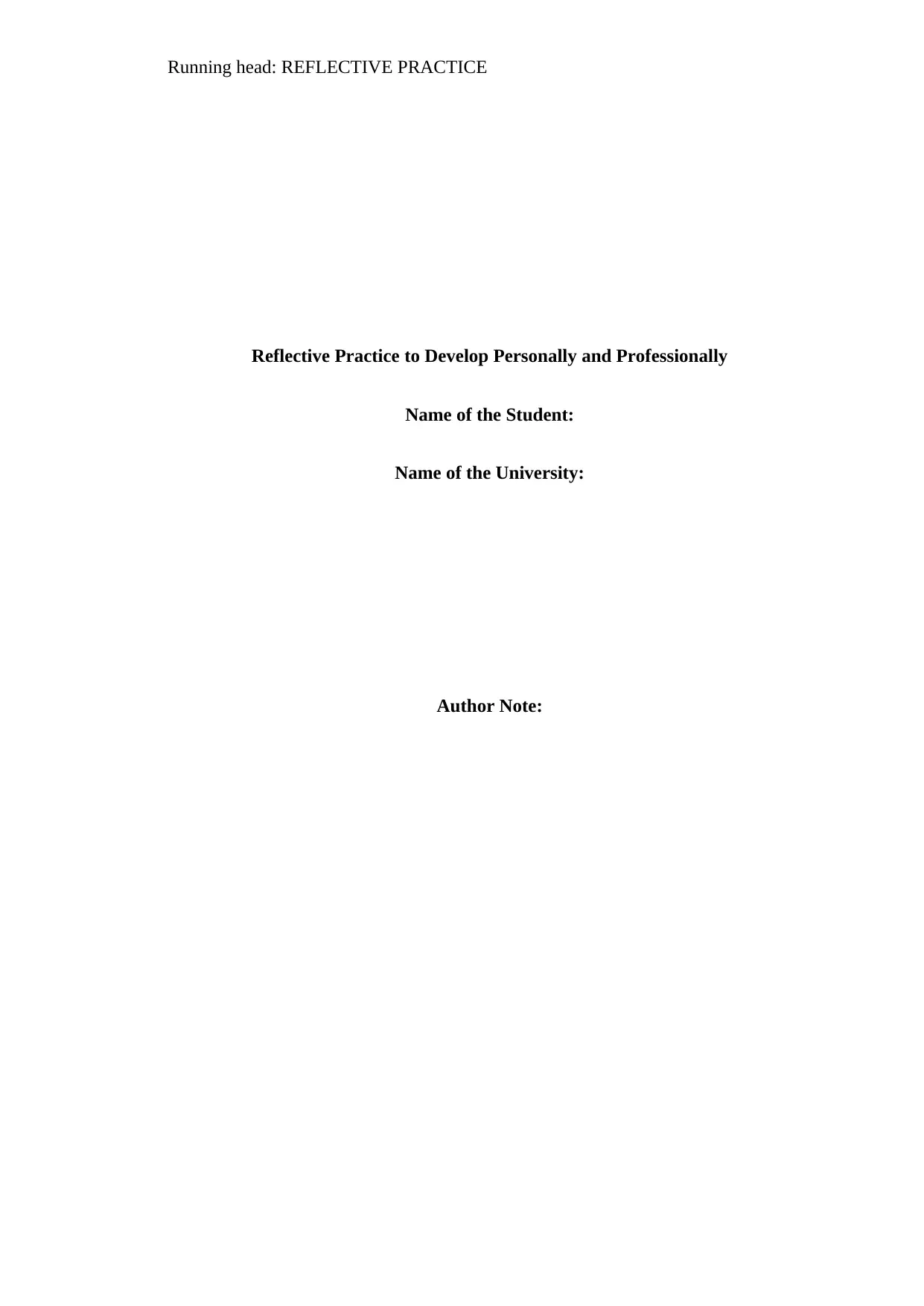
Running head: REFLECTIVE PRACTICE
Reflective Practice to Develop Personally and Professionally
Name of the Student:
Name of the University:
Author Note:
Reflective Practice to Develop Personally and Professionally
Name of the Student:
Name of the University:
Author Note:
Paraphrase This Document
Need a fresh take? Get an instant paraphrase of this document with our AI Paraphraser
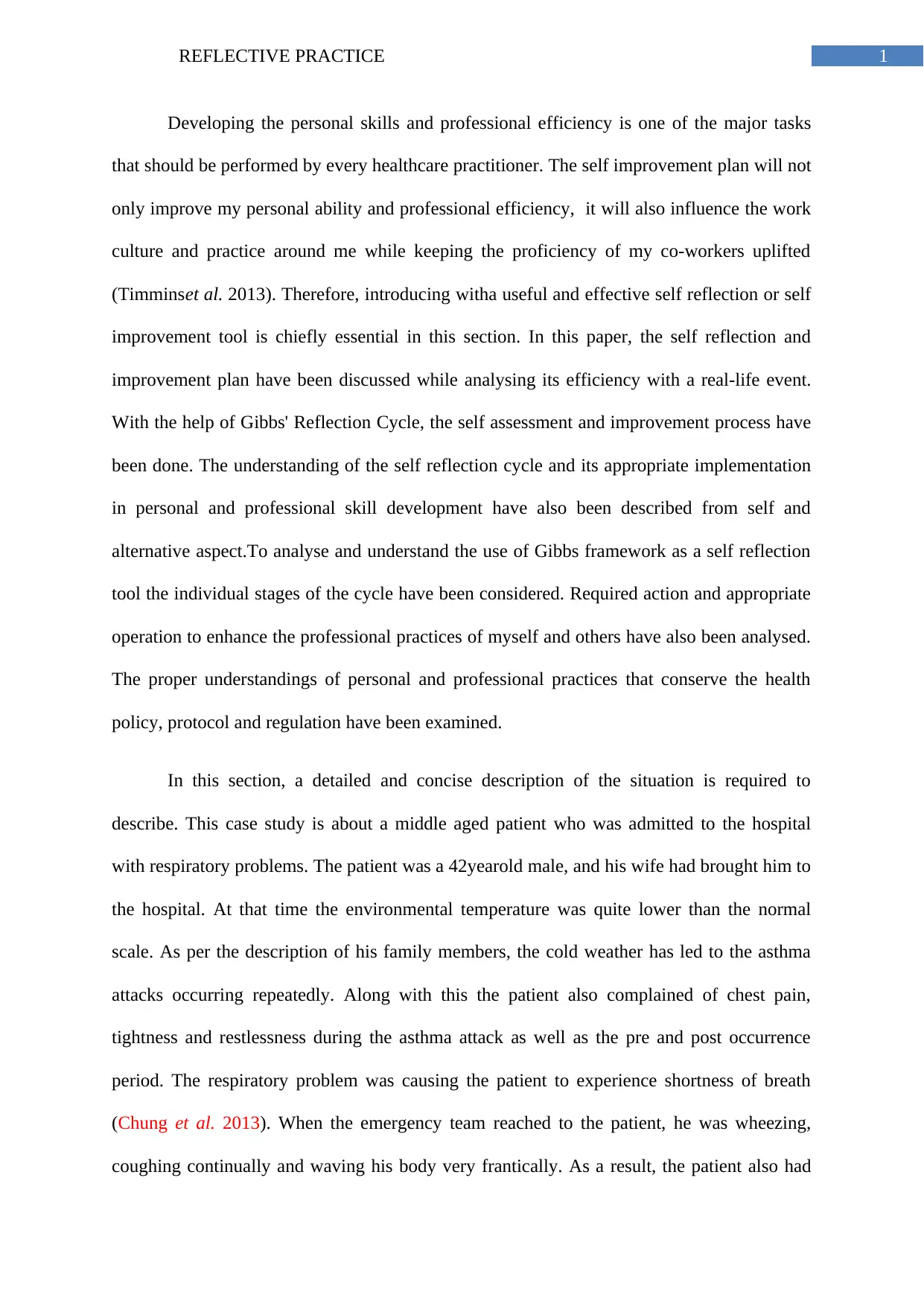
1REFLECTIVE PRACTICE
Developing the personal skills and professional efficiency is one of the major tasks
that should be performed by every healthcare practitioner. The self improvement plan will not
only improve my personal ability and professional efficiency, it will also influence the work
culture and practice around me while keeping the proficiency of my co-workers uplifted
(Timminset al. 2013). Therefore, introducing witha useful and effective self reflection or self
improvement tool is chiefly essential in this section. In this paper, the self reflection and
improvement plan have been discussed while analysing its efficiency with a real-life event.
With the help of Gibbs' Reflection Cycle, the self assessment and improvement process have
been done. The understanding of the self reflection cycle and its appropriate implementation
in personal and professional skill development have also been described from self and
alternative aspect.To analyse and understand the use of Gibbs framework as a self reflection
tool the individual stages of the cycle have been considered. Required action and appropriate
operation to enhance the professional practices of myself and others have also been analysed.
The proper understandings of personal and professional practices that conserve the health
policy, protocol and regulation have been examined.
In this section, a detailed and concise description of the situation is required to
describe. This case study is about a middle aged patient who was admitted to the hospital
with respiratory problems. The patient was a 42yearold male, and his wife had brought him to
the hospital. At that time the environmental temperature was quite lower than the normal
scale. As per the description of his family members, the cold weather has led to the asthma
attacks occurring repeatedly. Along with this the patient also complained of chest pain,
tightness and restlessness during the asthma attack as well as the pre and post occurrence
period. The respiratory problem was causing the patient to experience shortness of breath
(Chung et al. 2013). When the emergency team reached to the patient, he was wheezing,
coughing continually and waving his body very frantically. As a result, the patient also had
Developing the personal skills and professional efficiency is one of the major tasks
that should be performed by every healthcare practitioner. The self improvement plan will not
only improve my personal ability and professional efficiency, it will also influence the work
culture and practice around me while keeping the proficiency of my co-workers uplifted
(Timminset al. 2013). Therefore, introducing witha useful and effective self reflection or self
improvement tool is chiefly essential in this section. In this paper, the self reflection and
improvement plan have been discussed while analysing its efficiency with a real-life event.
With the help of Gibbs' Reflection Cycle, the self assessment and improvement process have
been done. The understanding of the self reflection cycle and its appropriate implementation
in personal and professional skill development have also been described from self and
alternative aspect.To analyse and understand the use of Gibbs framework as a self reflection
tool the individual stages of the cycle have been considered. Required action and appropriate
operation to enhance the professional practices of myself and others have also been analysed.
The proper understandings of personal and professional practices that conserve the health
policy, protocol and regulation have been examined.
In this section, a detailed and concise description of the situation is required to
describe. This case study is about a middle aged patient who was admitted to the hospital
with respiratory problems. The patient was a 42yearold male, and his wife had brought him to
the hospital. At that time the environmental temperature was quite lower than the normal
scale. As per the description of his family members, the cold weather has led to the asthma
attacks occurring repeatedly. Along with this the patient also complained of chest pain,
tightness and restlessness during the asthma attack as well as the pre and post occurrence
period. The respiratory problem was causing the patient to experience shortness of breath
(Chung et al. 2013). When the emergency team reached to the patient, he was wheezing,
coughing continually and waving his body very frantically. As a result, the patient also had
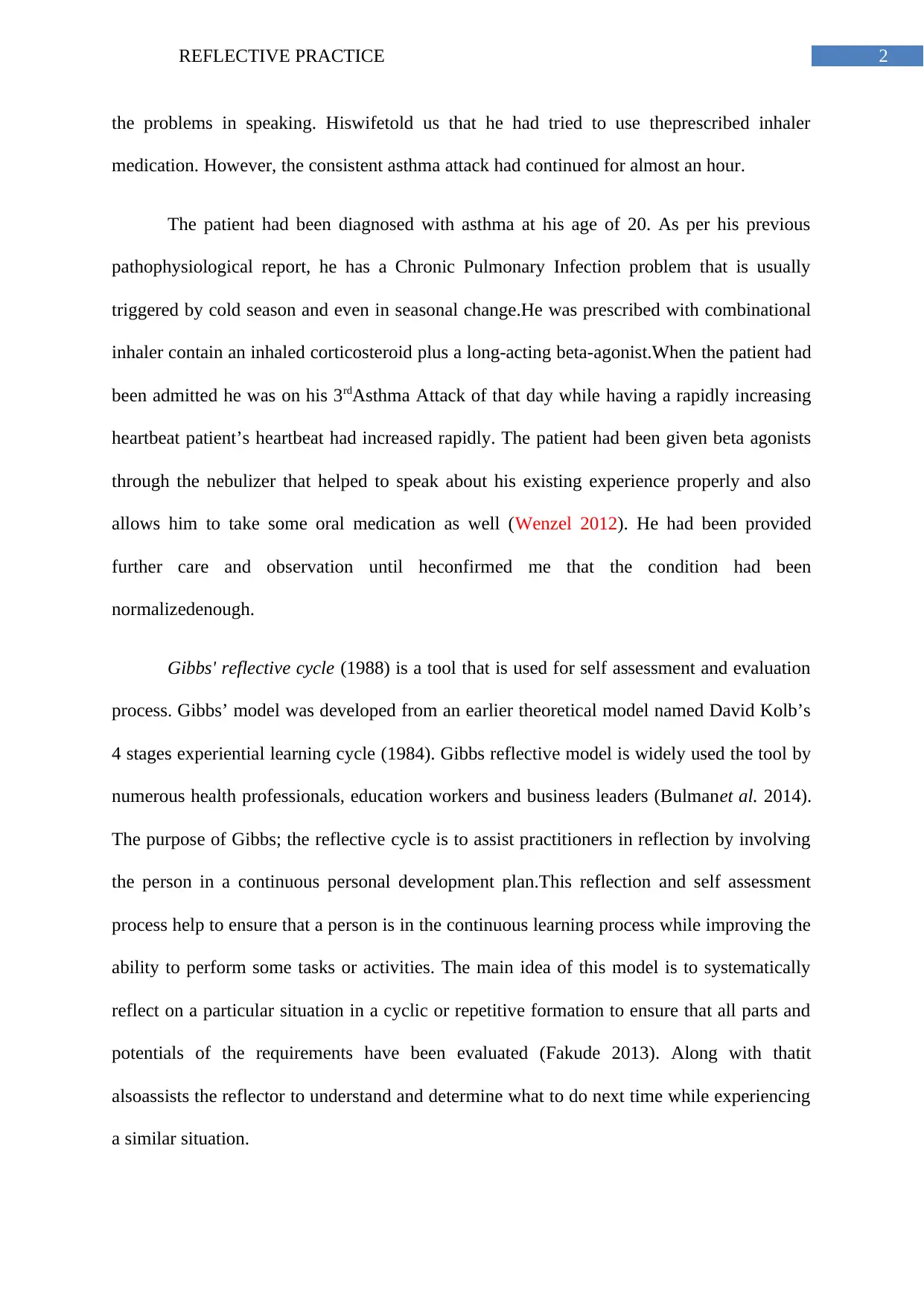
2REFLECTIVE PRACTICE
the problems in speaking. Hiswifetold us that he had tried to use theprescribed inhaler
medication. However, the consistent asthma attack had continued for almost an hour.
The patient had been diagnosed with asthma at his age of 20. As per his previous
pathophysiological report, he has a Chronic Pulmonary Infection problem that is usually
triggered by cold season and even in seasonal change.He was prescribed with combinational
inhaler contain an inhaled corticosteroid plus a long-acting beta-agonist.When the patient had
been admitted he was on his 3rdAsthma Attack of that day while having a rapidly increasing
heartbeat patient’s heartbeat had increased rapidly. The patient had been given beta agonists
through the nebulizer that helped to speak about his existing experience properly and also
allows him to take some oral medication as well (Wenzel 2012). He had been provided
further care and observation until heconfirmed me that the condition had been
normalizedenough.
Gibbs' reflective cycle (1988) is a tool that is used for self assessment and evaluation
process. Gibbs’ model was developed from an earlier theoretical model named David Kolb’s
4 stages experiential learning cycle (1984). Gibbs reflective model is widely used the tool by
numerous health professionals, education workers and business leaders (Bulmanet al. 2014).
The purpose of Gibbs; the reflective cycle is to assist practitioners in reflection by involving
the person in a continuous personal development plan.This reflection and self assessment
process help to ensure that a person is in the continuous learning process while improving the
ability to perform some tasks or activities. The main idea of this model is to systematically
reflect on a particular situation in a cyclic or repetitive formation to ensure that all parts and
potentials of the requirements have been evaluated (Fakude 2013). Along with thatit
alsoassists the reflector to understand and determine what to do next time while experiencing
a similar situation.
the problems in speaking. Hiswifetold us that he had tried to use theprescribed inhaler
medication. However, the consistent asthma attack had continued for almost an hour.
The patient had been diagnosed with asthma at his age of 20. As per his previous
pathophysiological report, he has a Chronic Pulmonary Infection problem that is usually
triggered by cold season and even in seasonal change.He was prescribed with combinational
inhaler contain an inhaled corticosteroid plus a long-acting beta-agonist.When the patient had
been admitted he was on his 3rdAsthma Attack of that day while having a rapidly increasing
heartbeat patient’s heartbeat had increased rapidly. The patient had been given beta agonists
through the nebulizer that helped to speak about his existing experience properly and also
allows him to take some oral medication as well (Wenzel 2012). He had been provided
further care and observation until heconfirmed me that the condition had been
normalizedenough.
Gibbs' reflective cycle (1988) is a tool that is used for self assessment and evaluation
process. Gibbs’ model was developed from an earlier theoretical model named David Kolb’s
4 stages experiential learning cycle (1984). Gibbs reflective model is widely used the tool by
numerous health professionals, education workers and business leaders (Bulmanet al. 2014).
The purpose of Gibbs; the reflective cycle is to assist practitioners in reflection by involving
the person in a continuous personal development plan.This reflection and self assessment
process help to ensure that a person is in the continuous learning process while improving the
ability to perform some tasks or activities. The main idea of this model is to systematically
reflect on a particular situation in a cyclic or repetitive formation to ensure that all parts and
potentials of the requirements have been evaluated (Fakude 2013). Along with thatit
alsoassists the reflector to understand and determine what to do next time while experiencing
a similar situation.
⊘ This is a preview!⊘
Do you want full access?
Subscribe today to unlock all pages.

Trusted by 1+ million students worldwide
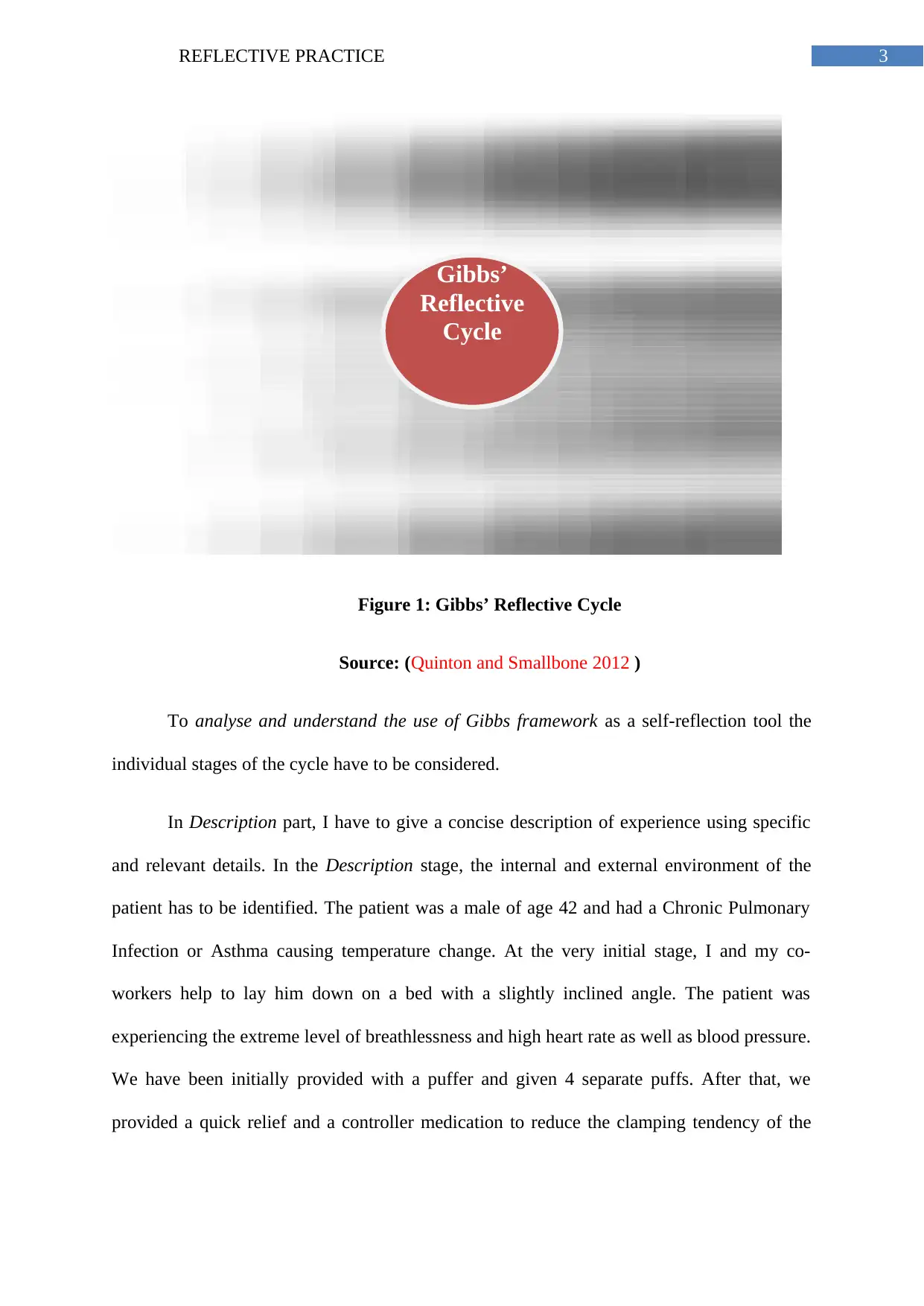
3REFLECTIVE PRACTICE
Figure 1: Gibbs’ Reflective Cycle
Source: (Quinton and Smallbone 2012 )
To analyse and understand the use of Gibbs framework as a self-reflection tool the
individual stages of the cycle have to be considered.
In Description part, I have to give a concise description of experience using specific
and relevant details. In the Description stage, the internal and external environment of the
patient has to be identified. The patient was a male of age 42 and had a Chronic Pulmonary
Infection or Asthma causing temperature change. At the very initial stage, I and my co-
workers help to lay him down on a bed with a slightly inclined angle. The patient was
experiencing the extreme level of breathlessness and high heart rate as well as blood pressure.
We have been initially provided with a puffer and given 4 separate puffs. After that, we
provided a quick relief and a controller medication to reduce the clamping tendency of the
ActionplanDescriptionFeelingsEvaluationAnalysisConclusionGibbs’
Reflective
Cycle
Figure 1: Gibbs’ Reflective Cycle
Source: (Quinton and Smallbone 2012 )
To analyse and understand the use of Gibbs framework as a self-reflection tool the
individual stages of the cycle have to be considered.
In Description part, I have to give a concise description of experience using specific
and relevant details. In the Description stage, the internal and external environment of the
patient has to be identified. The patient was a male of age 42 and had a Chronic Pulmonary
Infection or Asthma causing temperature change. At the very initial stage, I and my co-
workers help to lay him down on a bed with a slightly inclined angle. The patient was
experiencing the extreme level of breathlessness and high heart rate as well as blood pressure.
We have been initially provided with a puffer and given 4 separate puffs. After that, we
provided a quick relief and a controller medication to reduce the clamping tendency of the
ActionplanDescriptionFeelingsEvaluationAnalysisConclusionGibbs’
Reflective
Cycle
Paraphrase This Document
Need a fresh take? Get an instant paraphrase of this document with our AI Paraphraser
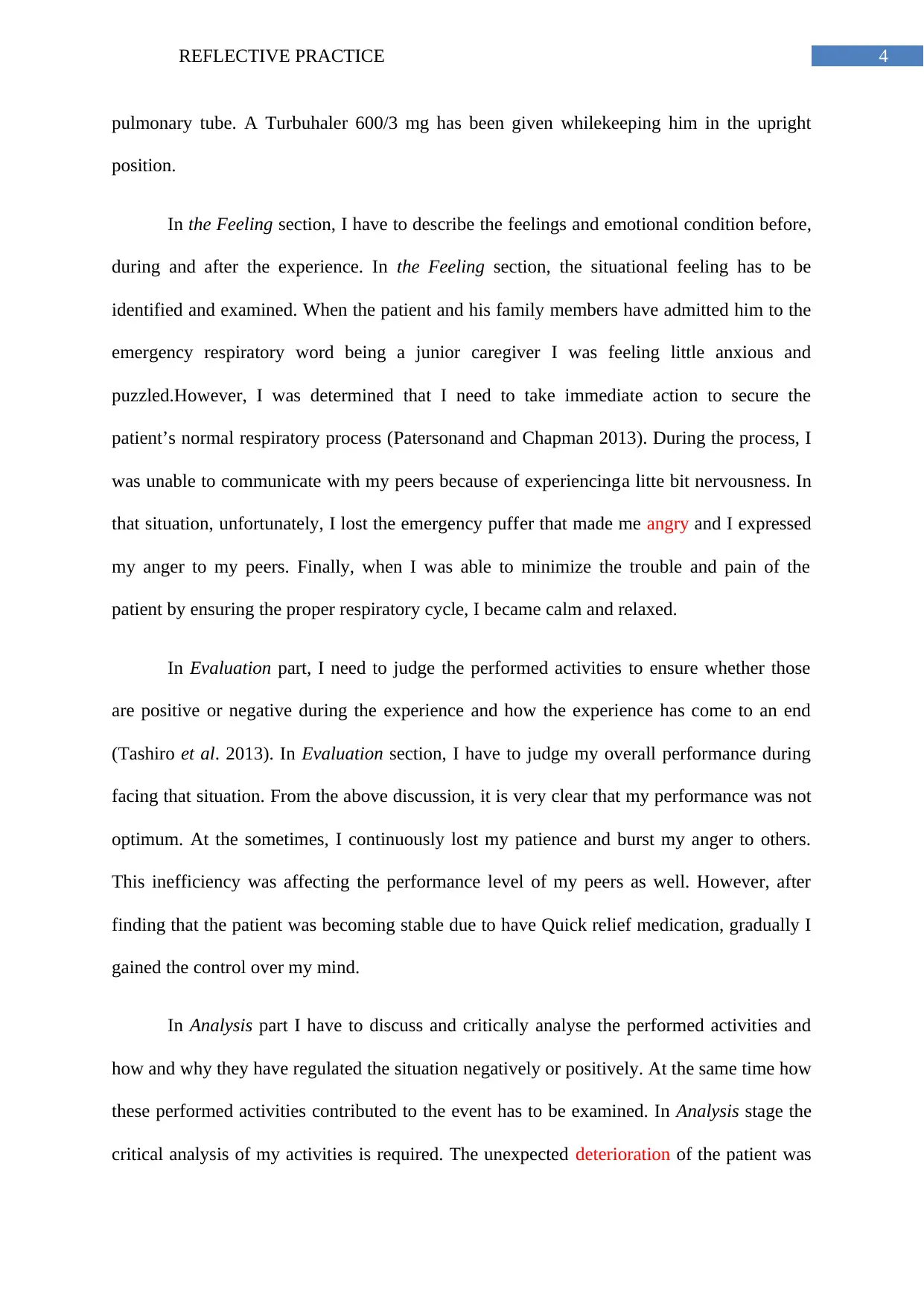
4REFLECTIVE PRACTICE
pulmonary tube. A Turbuhaler 600/3 mg has been given whilekeeping him in the upright
position.
In the Feeling section, I have to describe the feelings and emotional condition before,
during and after the experience. In the Feeling section, the situational feeling has to be
identified and examined. When the patient and his family members have admitted him to the
emergency respiratory word being a junior caregiver I was feeling little anxious and
puzzled.However, I was determined that I need to take immediate action to secure the
patient’s normal respiratory process (Patersonand and Chapman 2013). During the process, I
was unable to communicate with my peers because of experiencinga litte bit nervousness. In
that situation, unfortunately, I lost the emergency puffer that made me angry and I expressed
my anger to my peers. Finally, when I was able to minimize the trouble and pain of the
patient by ensuring the proper respiratory cycle, I became calm and relaxed.
In Evaluation part, I need to judge the performed activities to ensure whether those
are positive or negative during the experience and how the experience has come to an end
(Tashiro et al. 2013). In Evaluation section, I have to judge my overall performance during
facing that situation. From the above discussion, it is very clear that my performance was not
optimum. At the sometimes, I continuously lost my patience and burst my anger to others.
This inefficiency was affecting the performance level of my peers as well. However, after
finding that the patient was becoming stable due to have Quick relief medication, gradually I
gained the control over my mind.
In Analysis part I have to discuss and critically analyse the performed activities and
how and why they have regulated the situation negatively or positively. At the same time how
these performed activities contributed to the event has to be examined. In Analysis stage the
critical analysis of my activities is required. The unexpected deterioration of the patient was
pulmonary tube. A Turbuhaler 600/3 mg has been given whilekeeping him in the upright
position.
In the Feeling section, I have to describe the feelings and emotional condition before,
during and after the experience. In the Feeling section, the situational feeling has to be
identified and examined. When the patient and his family members have admitted him to the
emergency respiratory word being a junior caregiver I was feeling little anxious and
puzzled.However, I was determined that I need to take immediate action to secure the
patient’s normal respiratory process (Patersonand and Chapman 2013). During the process, I
was unable to communicate with my peers because of experiencinga litte bit nervousness. In
that situation, unfortunately, I lost the emergency puffer that made me angry and I expressed
my anger to my peers. Finally, when I was able to minimize the trouble and pain of the
patient by ensuring the proper respiratory cycle, I became calm and relaxed.
In Evaluation part, I need to judge the performed activities to ensure whether those
are positive or negative during the experience and how the experience has come to an end
(Tashiro et al. 2013). In Evaluation section, I have to judge my overall performance during
facing that situation. From the above discussion, it is very clear that my performance was not
optimum. At the sometimes, I continuously lost my patience and burst my anger to others.
This inefficiency was affecting the performance level of my peers as well. However, after
finding that the patient was becoming stable due to have Quick relief medication, gradually I
gained the control over my mind.
In Analysis part I have to discuss and critically analyse the performed activities and
how and why they have regulated the situation negatively or positively. At the same time how
these performed activities contributed to the event has to be examined. In Analysis stage the
critical analysis of my activities is required. The unexpected deterioration of the patient was
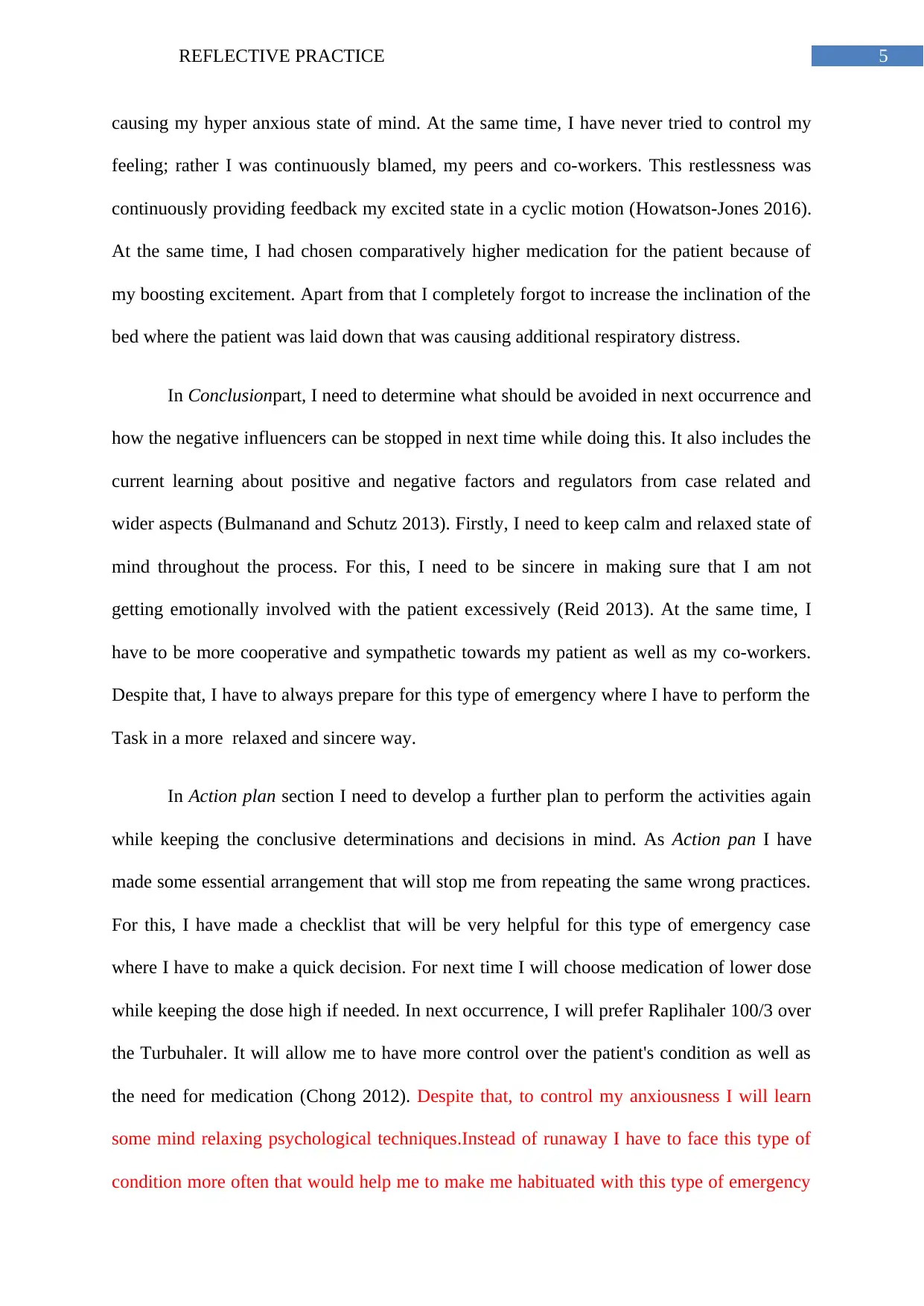
5REFLECTIVE PRACTICE
causing my hyper anxious state of mind. At the same time, I have never tried to control my
feeling; rather I was continuously blamed, my peers and co-workers. This restlessness was
continuously providing feedback my excited state in a cyclic motion (Howatson-Jones 2016).
At the same time, I had chosen comparatively higher medication for the patient because of
my boosting excitement. Apart from that I completely forgot to increase the inclination of the
bed where the patient was laid down that was causing additional respiratory distress.
In Conclusionpart, I need to determine what should be avoided in next occurrence and
how the negative influencers can be stopped in next time while doing this. It also includes the
current learning about positive and negative factors and regulators from case related and
wider aspects (Bulmanand and Schutz 2013). Firstly, I need to keep calm and relaxed state of
mind throughout the process. For this, I need to be sincere in making sure that I am not
getting emotionally involved with the patient excessively (Reid 2013). At the same time, I
have to be more cooperative and sympathetic towards my patient as well as my co-workers.
Despite that, I have to always prepare for this type of emergency where I have to perform the
Task in a more relaxed and sincere way.
In Action plan section I need to develop a further plan to perform the activities again
while keeping the conclusive determinations and decisions in mind. As Action pan I have
made some essential arrangement that will stop me from repeating the same wrong practices.
For this, I have made a checklist that will be very helpful for this type of emergency case
where I have to make a quick decision. For next time I will choose medication of lower dose
while keeping the dose high if needed. In next occurrence, I will prefer Raplihaler 100/3 over
the Turbuhaler. It will allow me to have more control over the patient's condition as well as
the need for medication (Chong 2012). Despite that, to control my anxiousness I will learn
some mind relaxing psychological techniques.Instead of runaway I have to face this type of
condition more often that would help me to make me habituated with this type of emergency
causing my hyper anxious state of mind. At the same time, I have never tried to control my
feeling; rather I was continuously blamed, my peers and co-workers. This restlessness was
continuously providing feedback my excited state in a cyclic motion (Howatson-Jones 2016).
At the same time, I had chosen comparatively higher medication for the patient because of
my boosting excitement. Apart from that I completely forgot to increase the inclination of the
bed where the patient was laid down that was causing additional respiratory distress.
In Conclusionpart, I need to determine what should be avoided in next occurrence and
how the negative influencers can be stopped in next time while doing this. It also includes the
current learning about positive and negative factors and regulators from case related and
wider aspects (Bulmanand and Schutz 2013). Firstly, I need to keep calm and relaxed state of
mind throughout the process. For this, I need to be sincere in making sure that I am not
getting emotionally involved with the patient excessively (Reid 2013). At the same time, I
have to be more cooperative and sympathetic towards my patient as well as my co-workers.
Despite that, I have to always prepare for this type of emergency where I have to perform the
Task in a more relaxed and sincere way.
In Action plan section I need to develop a further plan to perform the activities again
while keeping the conclusive determinations and decisions in mind. As Action pan I have
made some essential arrangement that will stop me from repeating the same wrong practices.
For this, I have made a checklist that will be very helpful for this type of emergency case
where I have to make a quick decision. For next time I will choose medication of lower dose
while keeping the dose high if needed. In next occurrence, I will prefer Raplihaler 100/3 over
the Turbuhaler. It will allow me to have more control over the patient's condition as well as
the need for medication (Chong 2012). Despite that, to control my anxiousness I will learn
some mind relaxing psychological techniques.Instead of runaway I have to face this type of
condition more often that would help me to make me habituated with this type of emergency
⊘ This is a preview!⊘
Do you want full access?
Subscribe today to unlock all pages.

Trusted by 1+ million students worldwide
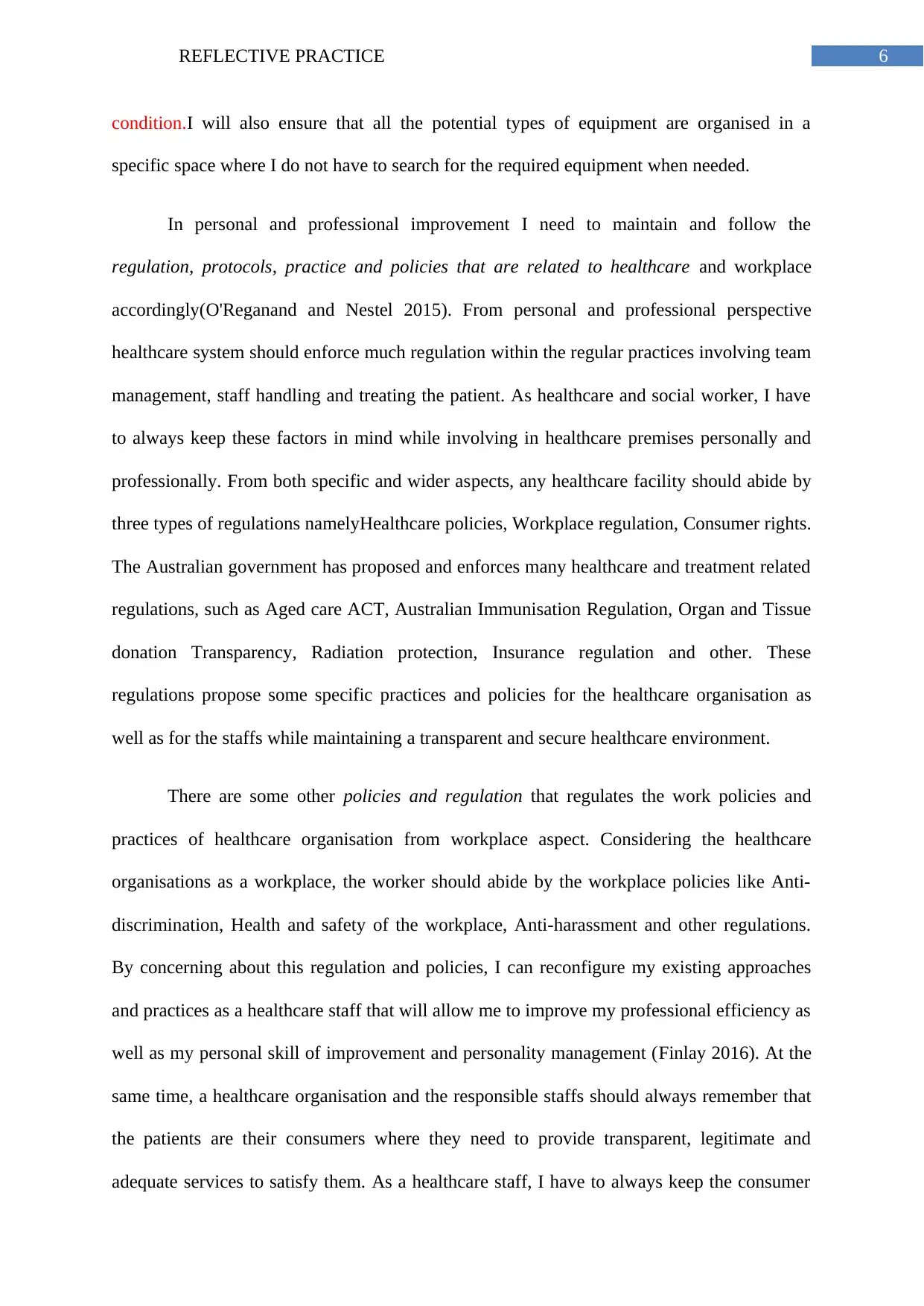
6REFLECTIVE PRACTICE
condition.I will also ensure that all the potential types of equipment are organised in a
specific space where I do not have to search for the required equipment when needed.
In personal and professional improvement I need to maintain and follow the
regulation, protocols, practice and policies that are related to healthcare and workplace
accordingly(O'Reganand and Nestel 2015). From personal and professional perspective
healthcare system should enforce much regulation within the regular practices involving team
management, staff handling and treating the patient. As healthcare and social worker, I have
to always keep these factors in mind while involving in healthcare premises personally and
professionally. From both specific and wider aspects, any healthcare facility should abide by
three types of regulations namelyHealthcare policies, Workplace regulation, Consumer rights.
The Australian government has proposed and enforces many healthcare and treatment related
regulations, such as Aged care ACT, Australian Immunisation Regulation, Organ and Tissue
donation Transparency, Radiation protection, Insurance regulation and other. These
regulations propose some specific practices and policies for the healthcare organisation as
well as for the staffs while maintaining a transparent and secure healthcare environment.
There are some other policies and regulation that regulates the work policies and
practices of healthcare organisation from workplace aspect. Considering the healthcare
organisations as a workplace, the worker should abide by the workplace policies like Anti-
discrimination, Health and safety of the workplace, Anti-harassment and other regulations.
By concerning about this regulation and policies, I can reconfigure my existing approaches
and practices as a healthcare staff that will allow me to improve my professional efficiency as
well as my personal skill of improvement and personality management (Finlay 2016). At the
same time, a healthcare organisation and the responsible staffs should always remember that
the patients are their consumers where they need to provide transparent, legitimate and
adequate services to satisfy them. As a healthcare staff, I have to always keep the consumer
condition.I will also ensure that all the potential types of equipment are organised in a
specific space where I do not have to search for the required equipment when needed.
In personal and professional improvement I need to maintain and follow the
regulation, protocols, practice and policies that are related to healthcare and workplace
accordingly(O'Reganand and Nestel 2015). From personal and professional perspective
healthcare system should enforce much regulation within the regular practices involving team
management, staff handling and treating the patient. As healthcare and social worker, I have
to always keep these factors in mind while involving in healthcare premises personally and
professionally. From both specific and wider aspects, any healthcare facility should abide by
three types of regulations namelyHealthcare policies, Workplace regulation, Consumer rights.
The Australian government has proposed and enforces many healthcare and treatment related
regulations, such as Aged care ACT, Australian Immunisation Regulation, Organ and Tissue
donation Transparency, Radiation protection, Insurance regulation and other. These
regulations propose some specific practices and policies for the healthcare organisation as
well as for the staffs while maintaining a transparent and secure healthcare environment.
There are some other policies and regulation that regulates the work policies and
practices of healthcare organisation from workplace aspect. Considering the healthcare
organisations as a workplace, the worker should abide by the workplace policies like Anti-
discrimination, Health and safety of the workplace, Anti-harassment and other regulations.
By concerning about this regulation and policies, I can reconfigure my existing approaches
and practices as a healthcare staff that will allow me to improve my professional efficiency as
well as my personal skill of improvement and personality management (Finlay 2016). At the
same time, a healthcare organisation and the responsible staffs should always remember that
the patients are their consumers where they need to provide transparent, legitimate and
adequate services to satisfy them. As a healthcare staff, I have to always keep the consumer
Paraphrase This Document
Need a fresh take? Get an instant paraphrase of this document with our AI Paraphraser
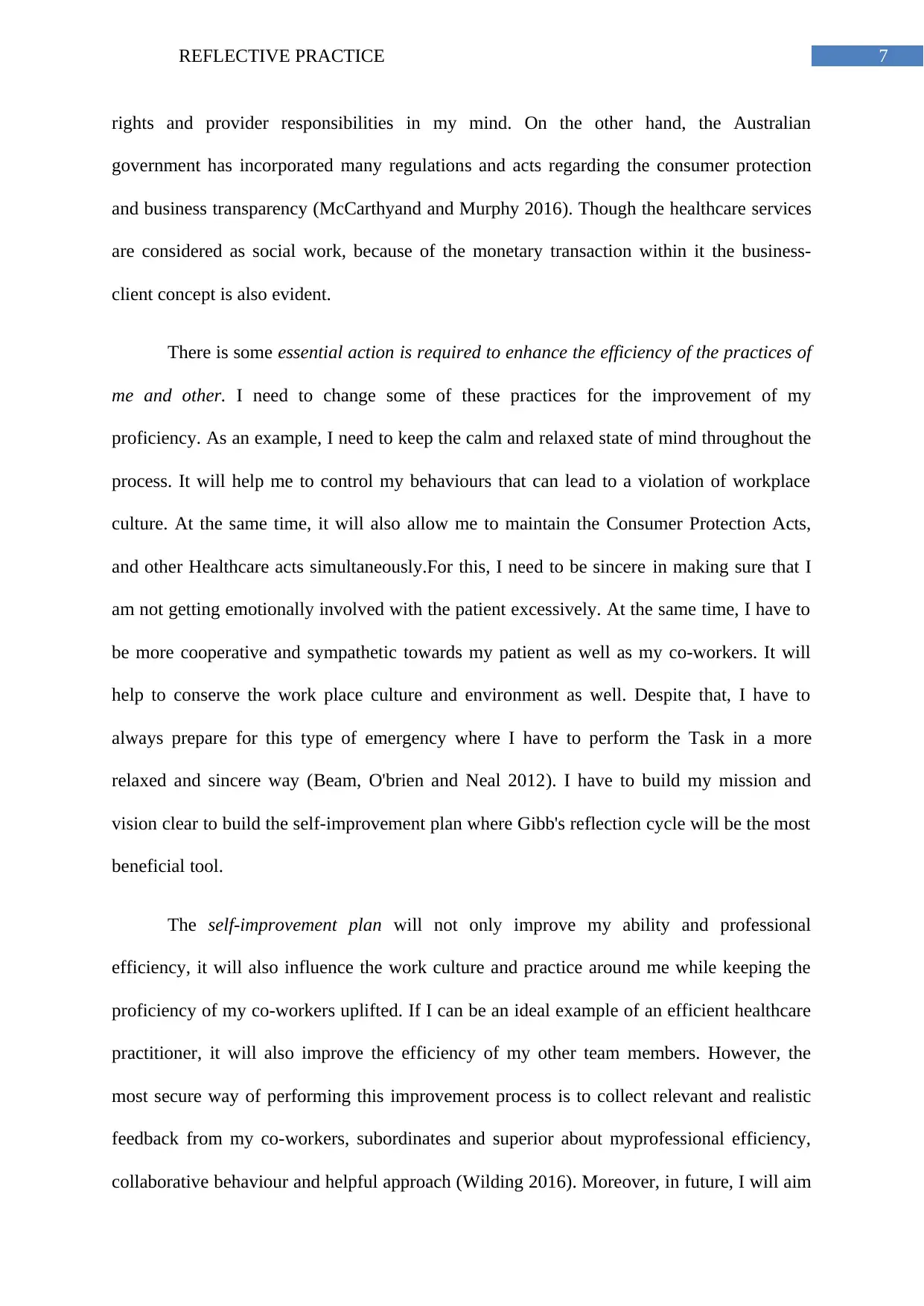
7REFLECTIVE PRACTICE
rights and provider responsibilities in my mind. On the other hand, the Australian
government has incorporated many regulations and acts regarding the consumer protection
and business transparency (McCarthyand and Murphy 2016). Though the healthcare services
are considered as social work, because of the monetary transaction within it the business-
client concept is also evident.
There is some essential action is required to enhance the efficiency of the practices of
me and other. I need to change some of these practices for the improvement of my
proficiency. As an example, I need to keep the calm and relaxed state of mind throughout the
process. It will help me to control my behaviours that can lead to a violation of workplace
culture. At the same time, it will also allow me to maintain the Consumer Protection Acts,
and other Healthcare acts simultaneously.For this, I need to be sincere in making sure that I
am not getting emotionally involved with the patient excessively. At the same time, I have to
be more cooperative and sympathetic towards my patient as well as my co-workers. It will
help to conserve the work place culture and environment as well. Despite that, I have to
always prepare for this type of emergency where I have to perform the Task in a more
relaxed and sincere way (Beam, O'brien and Neal 2012). I have to build my mission and
vision clear to build the self-improvement plan where Gibb's reflection cycle will be the most
beneficial tool.
The self-improvement plan will not only improve my ability and professional
efficiency, it will also influence the work culture and practice around me while keeping the
proficiency of my co-workers uplifted. If I can be an ideal example of an efficient healthcare
practitioner, it will also improve the efficiency of my other team members. However, the
most secure way of performing this improvement process is to collect relevant and realistic
feedback from my co-workers, subordinates and superior about myprofessional efficiency,
collaborative behaviour and helpful approach (Wilding 2016). Moreover, in future, I will aim
rights and provider responsibilities in my mind. On the other hand, the Australian
government has incorporated many regulations and acts regarding the consumer protection
and business transparency (McCarthyand and Murphy 2016). Though the healthcare services
are considered as social work, because of the monetary transaction within it the business-
client concept is also evident.
There is some essential action is required to enhance the efficiency of the practices of
me and other. I need to change some of these practices for the improvement of my
proficiency. As an example, I need to keep the calm and relaxed state of mind throughout the
process. It will help me to control my behaviours that can lead to a violation of workplace
culture. At the same time, it will also allow me to maintain the Consumer Protection Acts,
and other Healthcare acts simultaneously.For this, I need to be sincere in making sure that I
am not getting emotionally involved with the patient excessively. At the same time, I have to
be more cooperative and sympathetic towards my patient as well as my co-workers. It will
help to conserve the work place culture and environment as well. Despite that, I have to
always prepare for this type of emergency where I have to perform the Task in a more
relaxed and sincere way (Beam, O'brien and Neal 2012). I have to build my mission and
vision clear to build the self-improvement plan where Gibb's reflection cycle will be the most
beneficial tool.
The self-improvement plan will not only improve my ability and professional
efficiency, it will also influence the work culture and practice around me while keeping the
proficiency of my co-workers uplifted. If I can be an ideal example of an efficient healthcare
practitioner, it will also improve the efficiency of my other team members. However, the
most secure way of performing this improvement process is to collect relevant and realistic
feedback from my co-workers, subordinates and superior about myprofessional efficiency,
collaborative behaviour and helpful approach (Wilding 2016). Moreover, in future, I will aim
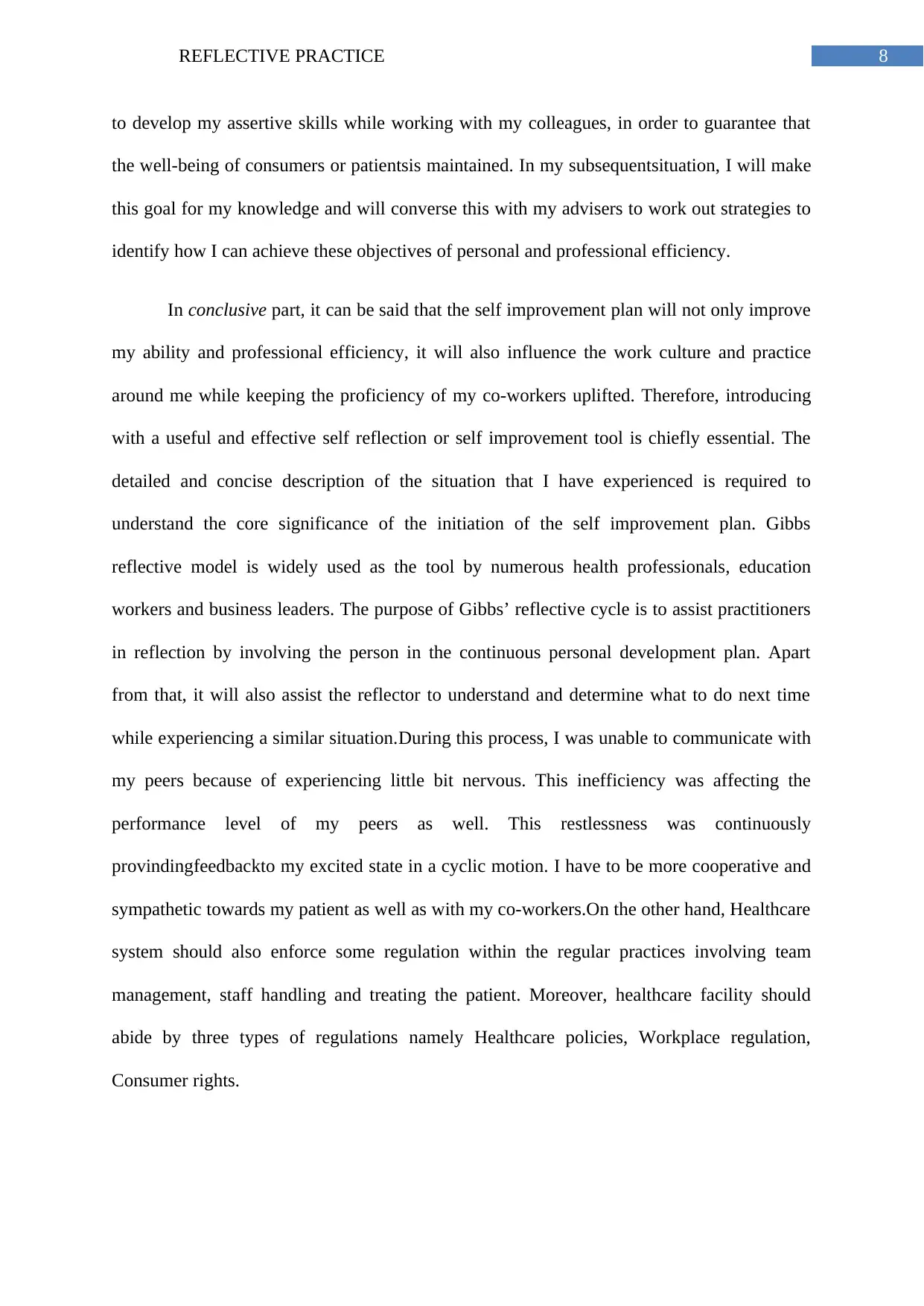
8REFLECTIVE PRACTICE
to develop my assertive skills while working with my colleagues, in order to guarantee that
the well-being of consumers or patientsis maintained. In my subsequentsituation, I will make
this goal for my knowledge and will converse this with my advisers to work out strategies to
identify how I can achieve these objectives of personal and professional efficiency.
In conclusive part, it can be said that the self improvement plan will not only improve
my ability and professional efficiency, it will also influence the work culture and practice
around me while keeping the proficiency of my co-workers uplifted. Therefore, introducing
with a useful and effective self reflection or self improvement tool is chiefly essential. The
detailed and concise description of the situation that I have experienced is required to
understand the core significance of the initiation of the self improvement plan. Gibbs
reflective model is widely used as the tool by numerous health professionals, education
workers and business leaders. The purpose of Gibbs’ reflective cycle is to assist practitioners
in reflection by involving the person in the continuous personal development plan. Apart
from that, it will also assist the reflector to understand and determine what to do next time
while experiencing a similar situation.During this process, I was unable to communicate with
my peers because of experiencing little bit nervous. This inefficiency was affecting the
performance level of my peers as well. This restlessness was continuously
provindingfeedbackto my excited state in a cyclic motion. I have to be more cooperative and
sympathetic towards my patient as well as with my co-workers.On the other hand, Healthcare
system should also enforce some regulation within the regular practices involving team
management, staff handling and treating the patient. Moreover, healthcare facility should
abide by three types of regulations namely Healthcare policies, Workplace regulation,
Consumer rights.
to develop my assertive skills while working with my colleagues, in order to guarantee that
the well-being of consumers or patientsis maintained. In my subsequentsituation, I will make
this goal for my knowledge and will converse this with my advisers to work out strategies to
identify how I can achieve these objectives of personal and professional efficiency.
In conclusive part, it can be said that the self improvement plan will not only improve
my ability and professional efficiency, it will also influence the work culture and practice
around me while keeping the proficiency of my co-workers uplifted. Therefore, introducing
with a useful and effective self reflection or self improvement tool is chiefly essential. The
detailed and concise description of the situation that I have experienced is required to
understand the core significance of the initiation of the self improvement plan. Gibbs
reflective model is widely used as the tool by numerous health professionals, education
workers and business leaders. The purpose of Gibbs’ reflective cycle is to assist practitioners
in reflection by involving the person in the continuous personal development plan. Apart
from that, it will also assist the reflector to understand and determine what to do next time
while experiencing a similar situation.During this process, I was unable to communicate with
my peers because of experiencing little bit nervous. This inefficiency was affecting the
performance level of my peers as well. This restlessness was continuously
provindingfeedbackto my excited state in a cyclic motion. I have to be more cooperative and
sympathetic towards my patient as well as with my co-workers.On the other hand, Healthcare
system should also enforce some regulation within the regular practices involving team
management, staff handling and treating the patient. Moreover, healthcare facility should
abide by three types of regulations namely Healthcare policies, Workplace regulation,
Consumer rights.
⊘ This is a preview!⊘
Do you want full access?
Subscribe today to unlock all pages.

Trusted by 1+ million students worldwide
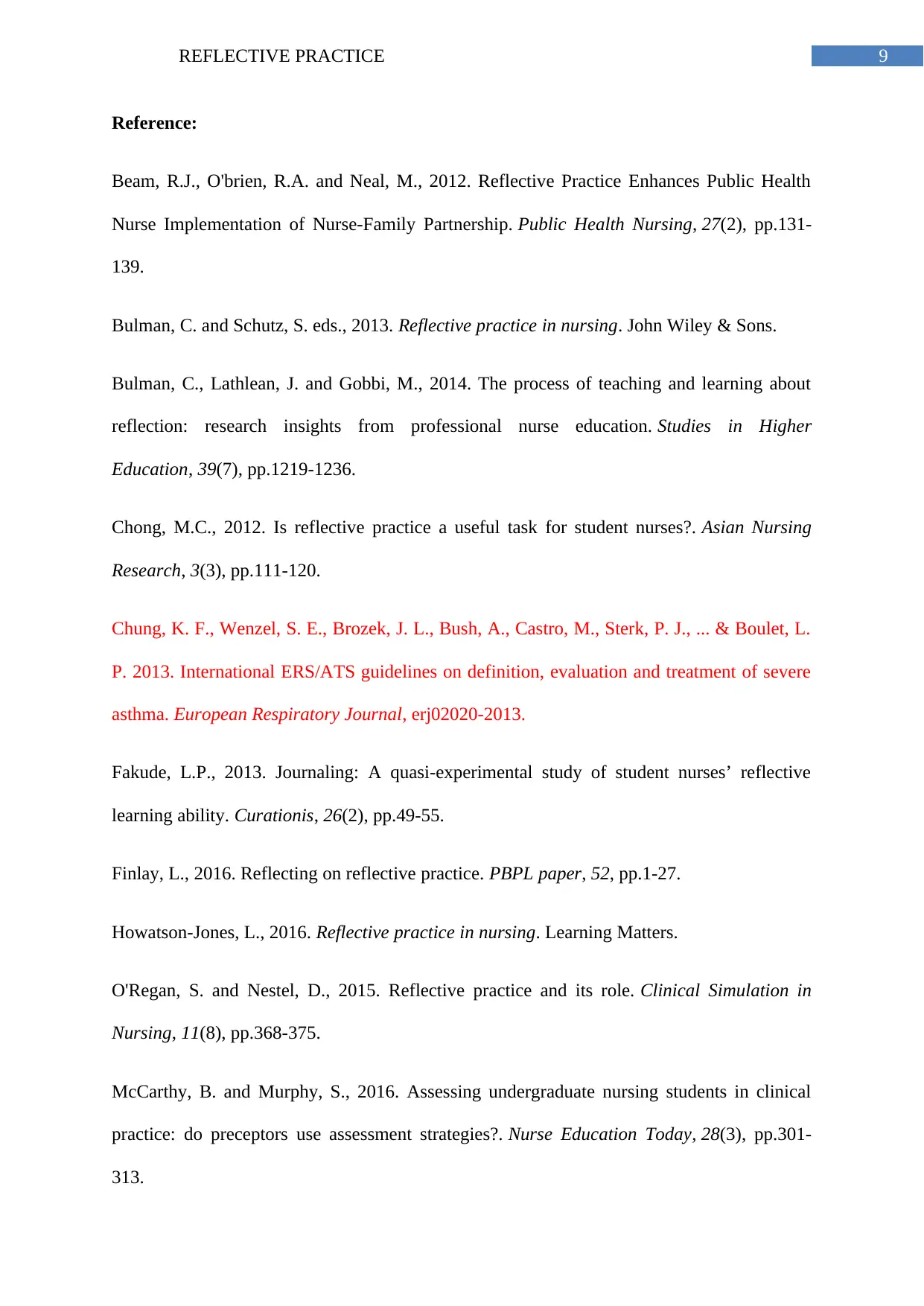
9REFLECTIVE PRACTICE
Reference:
Beam, R.J., O'brien, R.A. and Neal, M., 2012. Reflective Practice Enhances Public Health
Nurse Implementation of Nurse‐Family Partnership. Public Health Nursing, 27(2), pp.131-
139.
Bulman, C. and Schutz, S. eds., 2013. Reflective practice in nursing. John Wiley & Sons.
Bulman, C., Lathlean, J. and Gobbi, M., 2014. The process of teaching and learning about
reflection: research insights from professional nurse education. Studies in Higher
Education, 39(7), pp.1219-1236.
Chong, M.C., 2012. Is reflective practice a useful task for student nurses?. Asian Nursing
Research, 3(3), pp.111-120.
Chung, K. F., Wenzel, S. E., Brozek, J. L., Bush, A., Castro, M., Sterk, P. J., ... & Boulet, L.
P. 2013. International ERS/ATS guidelines on definition, evaluation and treatment of severe
asthma. European Respiratory Journal, erj02020-2013.
Fakude, L.P., 2013. Journaling: A quasi-experimental study of student nurses’ reflective
learning ability. Curationis, 26(2), pp.49-55.
Finlay, L., 2016. Reflecting on reflective practice. PBPL paper, 52, pp.1-27.
Howatson-Jones, L., 2016. Reflective practice in nursing. Learning Matters.
O'Regan, S. and Nestel, D., 2015. Reflective practice and its role. Clinical Simulation in
Nursing, 11(8), pp.368-375.
McCarthy, B. and Murphy, S., 2016. Assessing undergraduate nursing students in clinical
practice: do preceptors use assessment strategies?. Nurse Education Today, 28(3), pp.301-
313.
Reference:
Beam, R.J., O'brien, R.A. and Neal, M., 2012. Reflective Practice Enhances Public Health
Nurse Implementation of Nurse‐Family Partnership. Public Health Nursing, 27(2), pp.131-
139.
Bulman, C. and Schutz, S. eds., 2013. Reflective practice in nursing. John Wiley & Sons.
Bulman, C., Lathlean, J. and Gobbi, M., 2014. The process of teaching and learning about
reflection: research insights from professional nurse education. Studies in Higher
Education, 39(7), pp.1219-1236.
Chong, M.C., 2012. Is reflective practice a useful task for student nurses?. Asian Nursing
Research, 3(3), pp.111-120.
Chung, K. F., Wenzel, S. E., Brozek, J. L., Bush, A., Castro, M., Sterk, P. J., ... & Boulet, L.
P. 2013. International ERS/ATS guidelines on definition, evaluation and treatment of severe
asthma. European Respiratory Journal, erj02020-2013.
Fakude, L.P., 2013. Journaling: A quasi-experimental study of student nurses’ reflective
learning ability. Curationis, 26(2), pp.49-55.
Finlay, L., 2016. Reflecting on reflective practice. PBPL paper, 52, pp.1-27.
Howatson-Jones, L., 2016. Reflective practice in nursing. Learning Matters.
O'Regan, S. and Nestel, D., 2015. Reflective practice and its role. Clinical Simulation in
Nursing, 11(8), pp.368-375.
McCarthy, B. and Murphy, S., 2016. Assessing undergraduate nursing students in clinical
practice: do preceptors use assessment strategies?. Nurse Education Today, 28(3), pp.301-
313.
Paraphrase This Document
Need a fresh take? Get an instant paraphrase of this document with our AI Paraphraser
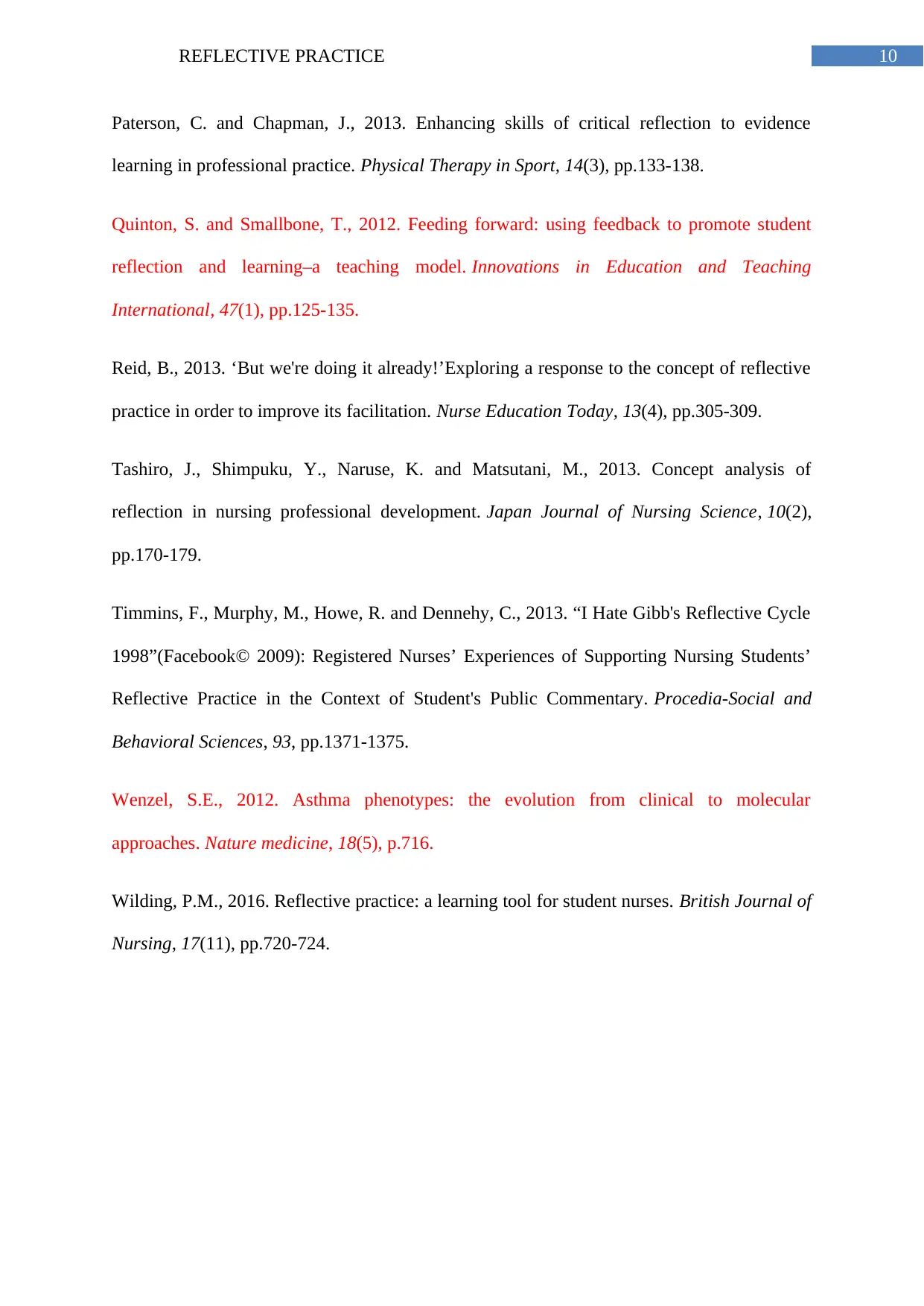
10REFLECTIVE PRACTICE
Paterson, C. and Chapman, J., 2013. Enhancing skills of critical reflection to evidence
learning in professional practice. Physical Therapy in Sport, 14(3), pp.133-138.
Quinton, S. and Smallbone, T., 2012. Feeding forward: using feedback to promote student
reflection and learning–a teaching model. Innovations in Education and Teaching
International, 47(1), pp.125-135.
Reid, B., 2013. ‘But we're doing it already!’Exploring a response to the concept of reflective
practice in order to improve its facilitation. Nurse Education Today, 13(4), pp.305-309.
Tashiro, J., Shimpuku, Y., Naruse, K. and Matsutani, M., 2013. Concept analysis of
reflection in nursing professional development. Japan Journal of Nursing Science, 10(2),
pp.170-179.
Timmins, F., Murphy, M., Howe, R. and Dennehy, C., 2013. “I Hate Gibb's Reflective Cycle
1998”(Facebook© 2009): Registered Nurses’ Experiences of Supporting Nursing Students’
Reflective Practice in the Context of Student's Public Commentary. Procedia-Social and
Behavioral Sciences, 93, pp.1371-1375.
Wenzel, S.E., 2012. Asthma phenotypes: the evolution from clinical to molecular
approaches. Nature medicine, 18(5), p.716.
Wilding, P.M., 2016. Reflective practice: a learning tool for student nurses. British Journal of
Nursing, 17(11), pp.720-724.
Paterson, C. and Chapman, J., 2013. Enhancing skills of critical reflection to evidence
learning in professional practice. Physical Therapy in Sport, 14(3), pp.133-138.
Quinton, S. and Smallbone, T., 2012. Feeding forward: using feedback to promote student
reflection and learning–a teaching model. Innovations in Education and Teaching
International, 47(1), pp.125-135.
Reid, B., 2013. ‘But we're doing it already!’Exploring a response to the concept of reflective
practice in order to improve its facilitation. Nurse Education Today, 13(4), pp.305-309.
Tashiro, J., Shimpuku, Y., Naruse, K. and Matsutani, M., 2013. Concept analysis of
reflection in nursing professional development. Japan Journal of Nursing Science, 10(2),
pp.170-179.
Timmins, F., Murphy, M., Howe, R. and Dennehy, C., 2013. “I Hate Gibb's Reflective Cycle
1998”(Facebook© 2009): Registered Nurses’ Experiences of Supporting Nursing Students’
Reflective Practice in the Context of Student's Public Commentary. Procedia-Social and
Behavioral Sciences, 93, pp.1371-1375.
Wenzel, S.E., 2012. Asthma phenotypes: the evolution from clinical to molecular
approaches. Nature medicine, 18(5), p.716.
Wilding, P.M., 2016. Reflective practice: a learning tool for student nurses. British Journal of
Nursing, 17(11), pp.720-724.
1 out of 11
Related Documents
Your All-in-One AI-Powered Toolkit for Academic Success.
+13062052269
info@desklib.com
Available 24*7 on WhatsApp / Email
![[object Object]](/_next/static/media/star-bottom.7253800d.svg)
Unlock your academic potential
Copyright © 2020–2025 A2Z Services. All Rights Reserved. Developed and managed by ZUCOL.





